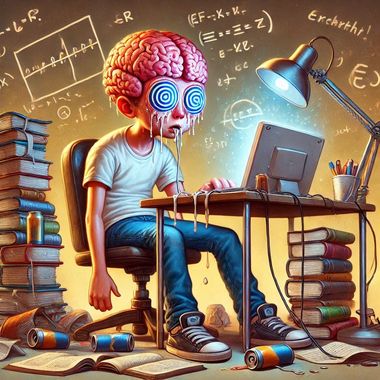From the Dean of Learning and Teaching
From Thoreau to TikTok: The Evolution of ‘Brain Rot’
Each year, the Oxford Dictionary identifies its word of the year. Lexicographers analyse the English language to determine words and expressions that have captured thematic aspects of our world over the last twelve months.
In 2024, the Oxford word was ‘brain rot’.

AI-generated image of a teenage boy experiencing brain rot. The irony is intentional.
‘Brain rot’ refers to the “supposed deterioration of a person’s mental or intellectual state, especially viewed as a result of overconsumption of material (now particularly online content) considered to be trivial or unchallenging. Also: something characterized [sic] as likely to lead to such deterioration.”
The first recorded use of ‘brain rot’ is believed to be in American writer Henry David Thoreau’s book, Walden (1854). In this work, Thoreau describes his experiences living in a self-built cabin in the woods of Massachusetts for two years, seeking to survive—and even thrive—by stripping away luxuries and embracing simplicity. He worries that “will not any endeavour to cure the brain-rot – which prevails…widely and fatally?”
Fast-forward to today, and thanks to TikTok, ‘brain rot’ has become fashionable among Gen Z and Gen Alpha, often used humorously or self-deprecatingly to describe endless scrolling or excessive meme consumption. Another slang term emerging from this trend is ‘skibidi’, a viral internet meme that represents something nonsensical. Meanwhile, another Oxford-shortlisted word, ‘slop,’ refers to low-quality, AI-generated content that lacks depth, authenticity, or accuracy.
Cue the chorus of voices lamenting the scourge of sloppy online content.
The issue, however, is that the online material responsible for ‘brain rot’ isn’t just low-quality—it’s addictive.
The Science of Social Media Addiction
Social media platforms don’t just serve up endless, often meaningless content—they also provide social rewards. Reactions, views, and shares generate dopamine and oxytocin, the so-called “happy hormones” that reinforce behaviour. Teenagers, still forming their identities and heavily reliant on peer feedback, are particularly susceptible. Their underdeveloped prefrontal cortex makes them more likely to engage in impulsive behaviours—meaning their brains are primed for ‘brain rot’ and will keep reaching for more.
Some research links adolescent loneliness, anxiety, and depression to excessive social media use, particularly prolonged exposure to low-quality online content (aka slop). Studies also suggest that this mental health impact may diminish motivation to engage in meaningful learning.
Strategies to Break the Dopamine Cycle
While social media can be hard to resist, there are practical strategies young people can use to regain control:
- Wait out the dopamine surge – Dopamine hits are usually short-lived. Instead of immediately returning to an online activity, take a five-minute break and reconsider whether you really want to continue.
- Find the ‘Goldilocks Zone’ – As discussed in last week’s article on ‘treaties vs. truces’ in parenting, finding a middle ground—not total restriction or unlimited access—can help teenagers develop healthier digital habits.
- Create microenvironments for different activities – Designate certain spaces for specific activities. For example, keeping the bedroom free of devices reinforces the idea that it’s a place for relaxation, not endless scrolling.
- Substitute, don’t ban – Instead of outright banning addictive content, find alternative activities that are still engaging but less corrosive to a young person’s well-being.
The Debate: Is ‘Brain Rot’ Overblown?
Some researchers challenge the idea that sloppy online content is harming brain health, arguing that IQ levels have actually increased since the twentieth century. However, there is broad consensus that boundaries around social media consumption are necessary.
One of the most effective buffers? School attendance.
Schools offer a structured break from the constant stream of digital stimulation. Beyond just keeping students away from streaming platforms and social media, school environments provide real-world social interactions that foster deeper, more meaningful connections. And yes—even interactions with teachers can be dopaminergic (believe it or not!).
Final Thoughts
While ‘brain rot’ may be the word of 2024, it doesn’t have to define this generation. Setting boundaries, fostering intentional consumption, and encouraging real-life interactions can help students develop healthier digital habits. After all, learning and growth happen when we engage actively, not passively—and that’s a lesson worth holding onto.
Sources:
Oxford Word of the Year 2024 - Oxford University Press
Why young brains are especially vulnerable to social media
4 tips to outsmart dopamine if your kid is hooked on screens or sweets : Shots - Health News : NPR
MS GRACE LOYDEN
Dean of Learning & Teaching